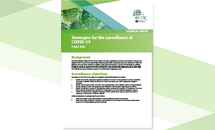Strategies for the surveillance of COVID-19
New version of this document is available!
This document proposes an updated strategy for COVID-19 surveillance at national and EU/EEA level that specifically aims to reconcile the data needs for effective pandemic response with what is still feasible in countries and within healthcare systems under siege, while taking into account guidance issued by the World Health Organization.
Executive Summary
The current surveillance objectives at national and EU/EEA level are as follows:
- Monitor the intensity, geographic spread and severity of COVID-19 in the population in order to estimate the burden of disease, assess the direction of recent time trends and inform appropriate mitigation measures.
- Monitor viral changes to inform drug and vaccine development, and to identify markers of severe infection.
- Monitor changes in which risk groups are most affected in order to better target prevention efforts.
- Monitor the epidemic’s impact on the healthcare system to predict the trajectory of the epidemic curve and inform resource allocation and mobilisation of surge capacity as well as external emergency support.
- Monitor the impact of any mitigation measures to inform authorities so they can adjust the choice of measures, as well as their timing and intensity.
Additional objectives at national level are to:
- Detect and contain nosocomial outbreaks to protect healthcare workers and patients.
- Detect and contain outbreaks in long-term care facilities and other closed communities to protect those most at risk of severe disease and poor outcomes.
The document outlines the surveillance approaches to achieve these objectives, minimum reporting to ECDC and testing priorities in case of limited resources.
Download






